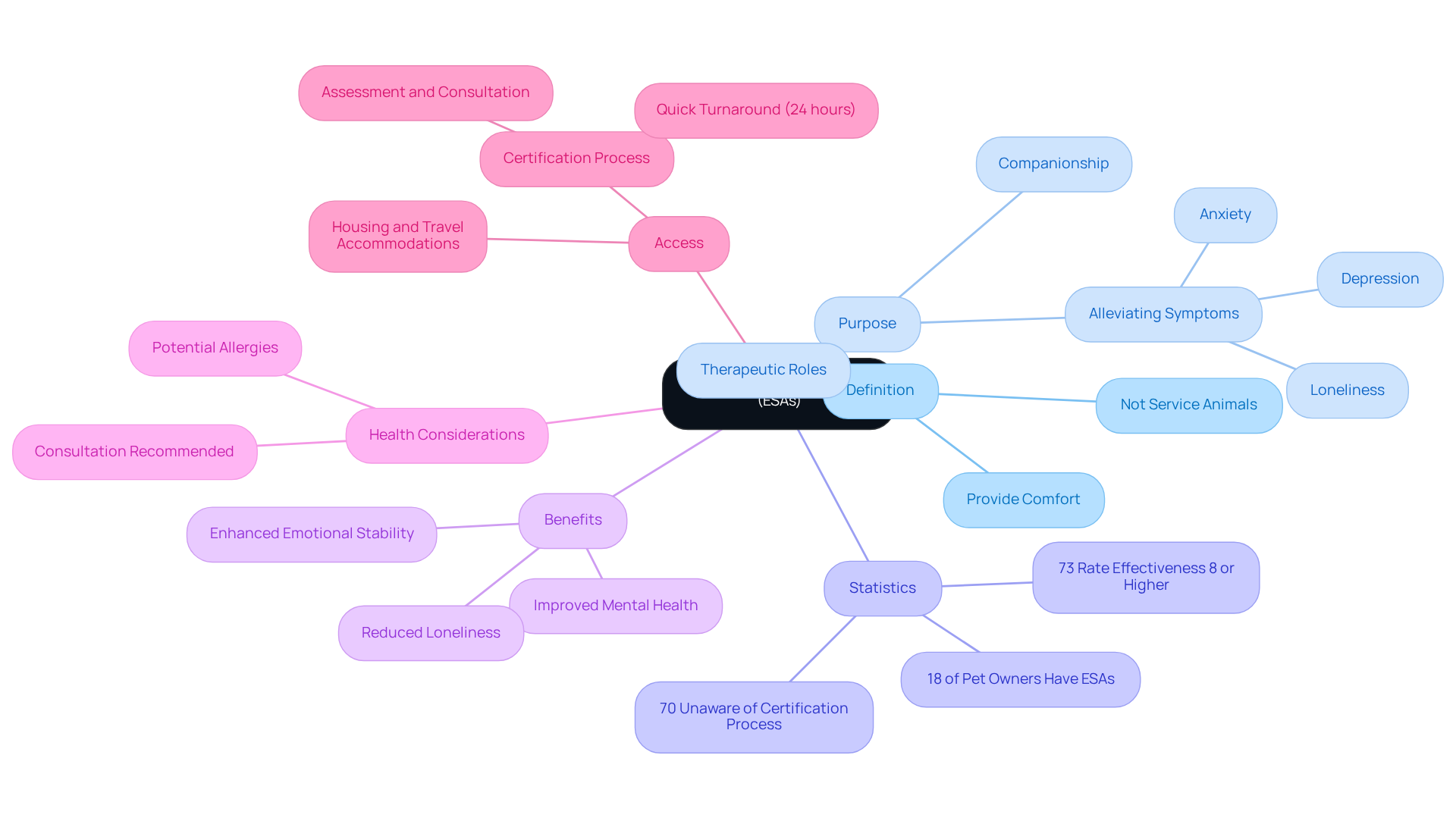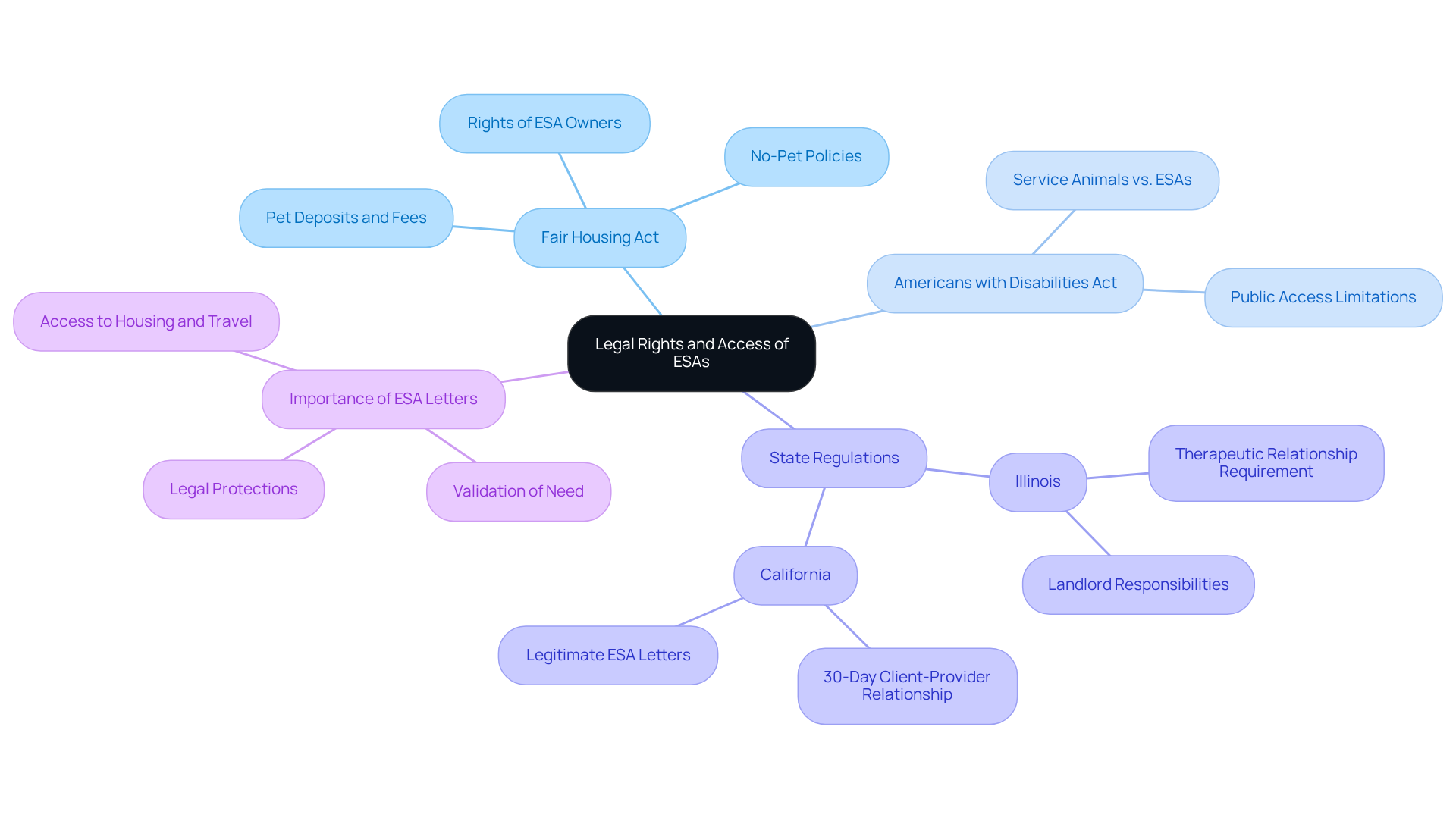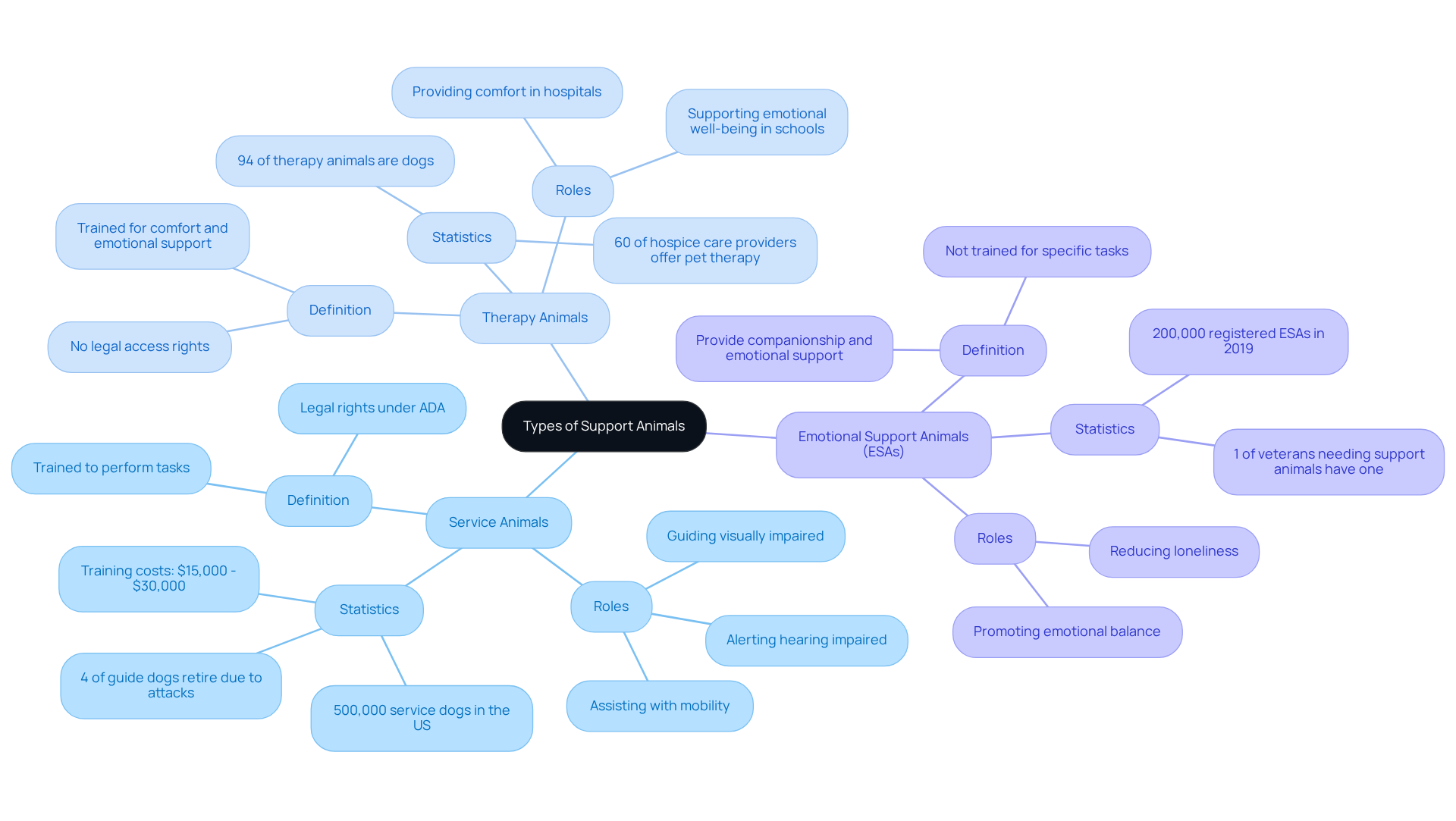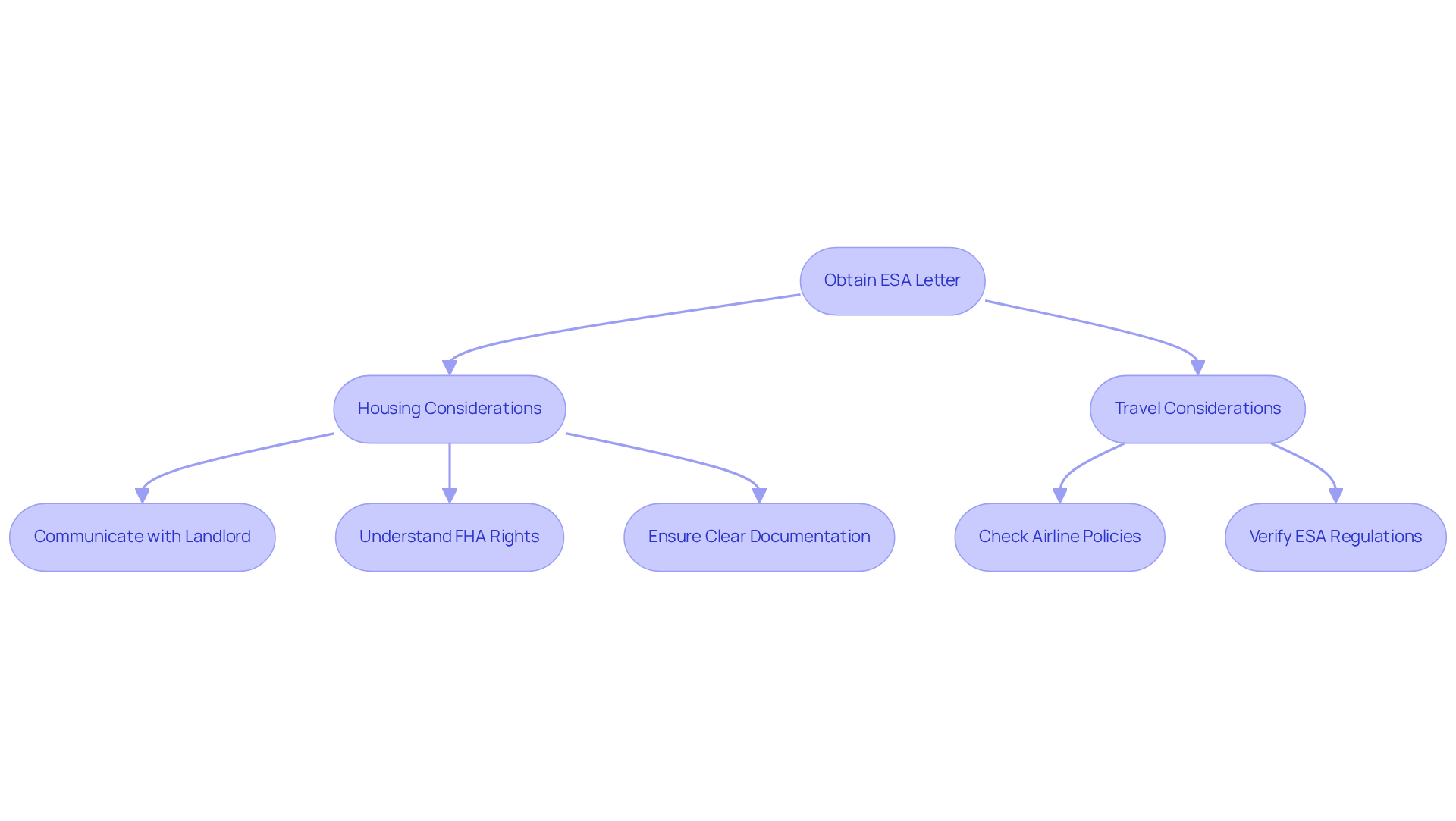

Can ESA Go Anywhere? Understanding Their Rights and Access
by Lena Park
Last updated: July 11, 2025
Verified and Approved by:
Angela Morris,
MSW, LCSW
Fact Checked

Overview
Emotional Support Animals (ESAs) hold unique rights and access that set them apart from service animals. They are permitted to live in no-pets housing under the Fair Housing Act, yet they do not enjoy the same public access rights. This distinction can be challenging for many individuals who rely on ESAs for emotional support. While these animals can provide essential comfort, their presence in public spaces is often limited to establishments with pet-friendly policies. It is crucial for ESA owners to understand their legal rights and to advocate effectively for their needs.
Many individuals struggle with mental health issues, feeling isolated and overwhelmed. The presence of an ESA can be a lifeline, offering companionship and emotional stability. However, navigating the complexities of access rights can add to the stress. By understanding the specific rights of ESAs, individuals can feel empowered to seek the support they need.
If you find yourself in this situation, remember that you are not alone. There are compassionate solutions available, such as obtaining an ESA letter, which can help clarify your rights and facilitate access to housing and certain public spaces. Your emotional well-being is important, and having the right support can make a significant difference in your life.
Reflect on your own experiences: have you ever felt the comfort of an ESA? Their presence can foster a sense of connection and understanding, reminding us that support is always within reach. As you navigate the journey of emotional health, know that there are resources and communities ready to support you and your beloved ESA.
Introduction
Understanding the role of Emotional Support Animals (ESAs) is crucial in a world where mental health awareness is on the rise. Many individuals face emotional and psychological challenges that can feel overwhelming and isolating. These animals provide essential companionship and comfort, yet many people remain unaware of their rights and the legal landscape surrounding ESAs. As the distinction between ESAs and service animals becomes increasingly important, questions arise about where these supportive companions can truly go and what rights their owners possess.
How can ESA owners navigate the complexities of access and legal protections to ensure they receive the support they need? The journey towards mental wellness can be daunting, but knowing that support is available can make a significant difference.
Define Emotional Support Animals and Their Purpose
Emotional Support Animals (ESAs) offer vital companionship for individuals grappling with emotional or psychological challenges. These animals, unlike service animals that undergo specialized training, are not required to have specific skills. Their primary purpose is to provide comfort, ease feelings of loneliness, and help alleviate symptoms related to anxiety, depression, and other mental health disorders. Consider this: approximately 18% of pet owners in the U.S. have emotional support animals, yet many remain unaware of how to obtain certification for their pets. This situation underscores significant barriers to accessing educational savings accounts.
Wellness Wag provides a streamlined online process for acquiring legitimate ESA letters through telehealth services, simplifying access to the support individuals need. Many owners of emotional support animals report remarkable improvements in their mental health; indeed, 73% of them rated their pets’ effectiveness in enhancing their well-being as eight or higher on a scale of ten. This statistic highlights the crucial role ESAs play in therapeutic practices, as their presence can foster emotional stability and promote healthier routines.
Moreover, research indicates that individuals with emotional support animals experience significant reductions in loneliness and depression over time, emphasizing their positive impact on mental well-being. It’s essential to recognize, however, that not everyone may benefit from ESAs due to potential allergies or health risks, which is why consulting a doctor before introducing one into your life is important.
Additionally, emotional support animals can go anywhere in university housing, ensuring equal opportunities for students with disabilities to fully engage in residential life. Ultimately, emotional support animals are not just pets; they are integral to the emotional support system for many, bridging the gap between companionship and mental health care. As Dr. Christine Crawford emphasizes, it is vital for clinicians to understand the advantages of erythropoiesis-stimulating agents, reinforcing their importance in mental health care.

Understand the Legal Rights and Access of ESAs
Living with mental health challenges can be incredibly difficult, and for many individuals, the companionship of an emotional support animal (ESA) can provide essential comfort and stability. Under the Fair Housing Act (FHA), individuals with valid ESA letters are granted the privilege of living with their emotional support companions in housing that typically restricts pets. This federal law requires landlords to make reasonable accommodations for ESA owners, allowing them to reside in ‘no-pets’ housing without facing pet deposits or fees.
However, it’s important to understand that emotional support animals do not have the same public access rights as service animals under the Americans with Disabilities Act (ADA). While service animals are trained to perform specific tasks for individuals with disabilities and can accompany their owners in all public spaces, it’s important to note that emotional support animals can go anywhere, although they are generally not permitted in places like restaurants, stores, and public transportation unless those establishments have a pet-friendly policy. This distinction can be frustrating for ESA owners, especially when they face barriers to accessing public spaces.
In 2022, there were 33,007 fair housing complaints, highlighting the ongoing struggles that ESA owners encounter in asserting their rights. Mental health professionals stress the importance of obtaining a legitimate ESA letter, which must validate the individual’s need for an emotional support animal due to a mental or emotional disability. This documentation is vital for ensuring protections under the FHA.
Consider the legal landscape for ESAs:
- In Illinois, a ‘therapeutic relationship’ with a healthcare provider is required for ESA letters.
- In California, a 30-day client-provider relationship is mandated before issuing such letters.
These state-specific regulations can significantly impact the privileges and responsibilities of ESA owners, underscoring the need for individuals to remain informed about local laws.
Understanding these legal differences is essential for ESA owners to effectively advocate for their rights and navigate the complexities of housing and public access, especially since their animals can go anywhere. Remember, you are not alone in this journey; support is available, and with the right information, you can promote your interests with confidence.

Differentiate Between Service Animals, Therapy Animals, and ESAs
Service creatures, as defined by the Americans with Disabilities Act (ADA), are specially trained dogs that perform essential tasks for individuals with disabilities. These tasks can include guiding the visually impaired or alerting those with hearing impairments. These remarkable animals hold legal privileges that allow them to accompany their owners into various public spaces, providing crucial support.
In contrast, therapy creatures are trained to offer comfort and emotional assistance in therapeutic environments like hospitals and schools. However, they do not possess the same legal access rights as service animals.
Emotional Support Animals (ESAs) provide companionship and emotional support but are not specifically trained to perform tasks. Understanding these distinctions is vital for individuals seeking the right form of support.
In 2019, there were nearly 200,000 registered emotional support creatures in the U.S., highlighting their growing recognition in mental health care. With approximately 61 million adults in the U.S. affected by disabilities, grasping these differences can empower individuals to navigate their rights and access necessary support, especially in environments where legal protections can vary significantly.
Additionally, Animal-Assisted Therapy (AAT) has been shown to reduce blood pressure and anxiety in patients, emphasizing the therapeutic benefits associated with therapy beings. However, service animal owners often encounter challenges, such as interference from other animals, complicating their experiences. Recognizing these factors is essential for those seeking appropriate support, as it fosters a deeper understanding of the journey toward emotional well-being.

Explore Practical Considerations for ESA Owners
For many individuals facing mental health challenges, obtaining a valid ESA letter from a licensed mental health professional is not just a formality; it is a crucial step in accessing the support they need. This documentation is essential for exercising housing privileges under the Fair Housing Act (FHA), and it can make a significant difference in their living situation. Engaging in open and transparent dialogue with landlords about entitlements and responsibilities is vital, especially in environments where pets are restricted. It is important for owners to ensure that landlords fully understand the specific requirements for keeping an ESA. Clear communication can help prevent misunderstandings and foster smoother accommodations, ultimately easing the burden on ESA owners.
Moreover, when it comes to traveling, staying informed about current airline policies is essential, especially since many airlines have changed their stance on whether ESAs can go anywhere as service animals. This shift can profoundly affect travel plans, making it imperative for ESA owners to verify airline regulations in advance, especially since ESA can go anywhere. By being well-informed and prepared, ESA owners can navigate these challenges with confidence and advocate for their rights effectively. Remember, you are not alone in this journey; support is available, and by taking these steps, you are prioritizing your well-being and that of your beloved ESA.

Conclusion
Emotional Support Animals (ESAs) hold a vital place in enhancing the mental well-being of individuals grappling with emotional and psychological challenges. Though they are not trained for specific tasks like service animals, their presence offers invaluable comfort and companionship, alleviating feelings of anxiety, depression, and loneliness. It is essential for individuals to understand the rights and access of ESAs to navigate the complexities of housing and public spaces effectively.
This article explores the legal framework surrounding ESAs, shedding light on their rights under the Fair Housing Act, which permits them to reside in pet-restricted housing. It clarifies that ESAs do not possess the same public access rights as service animals. The importance of obtaining a legitimate ESA letter is emphasized, ensuring protections while highlighting the necessity of being informed about state-specific regulations. Additionally, the distinctions between service animals, therapy animals, and ESAs are outlined, empowering readers to make informed decisions regarding their support needs.
Ultimately, recognizing the significance of ESAs and their legal rights encourages individuals to advocate for themselves and their companions. By staying informed about current laws and regulations, ESA owners can navigate challenges related to housing and travel with confidence. The journey to emotional well-being is supported by the companionship of these animals, and acknowledging their role in mental health care is vital for fostering a more inclusive and understanding environment for all.
Frequently Asked Questions
What are Emotional Support Animals (ESAs)?
Emotional Support Animals (ESAs) are pets that provide companionship and comfort to individuals facing emotional or psychological challenges. Unlike service animals, ESAs do not require specialized training and primarily aim to alleviate feelings of loneliness and symptoms related to mental health disorders such as anxiety and depression.
How prevalent are Emotional Support Animals among pet owners?
Approximately 18% of pet owners in the U.S. have Emotional Support Animals, although many are unaware of the process to obtain certification for their pets.
How can someone obtain an ESA letter?
Wellness Wag offers a streamlined online process for acquiring legitimate ESA letters through telehealth services, making it easier for individuals to access the support they need.
What impact do ESAs have on mental health?
Many owners of Emotional Support Animals report significant improvements in their mental health, with 73% rating their pets’ effectiveness in enhancing their well-being as eight or higher on a scale of ten. Research indicates that individuals with ESAs experience reductions in loneliness and depression over time.
Are there any health considerations to keep in mind regarding ESAs?
It is important to consult a doctor before introducing an Emotional Support Animal into your life, as some individuals may have allergies or health risks that could be exacerbated by having a pet.
Where can Emotional Support Animals go?
Emotional Support Animals are allowed in university housing, ensuring that students with disabilities can fully participate in residential life.
What role do ESAs play in mental health care?
Emotional Support Animals are considered integral to the emotional support system for many individuals, bridging the gap between companionship and mental health care, thereby fostering emotional stability and promoting healthier routines.
Certify Your Emotional Support Animal Today

Why You Can Rely on Us?
At Wellness Wag, we believe your pet deserves care rooted in both science and compassion. Each article is carefully researched, written in clear language for pet owners, and then reviewed by qualified professionals to ensure the information is evidence-based, current, and practical for real-life care. Our goal is to help you feel confident in making informed decisions about your pet’s health and well-being.
Reviewed by
Angela Morris, MSW, LCSW
Angela is a licensed clinical social worker with 20 years of experience in patient advocacy and community mental health. She has assisted numerous clients with ESA evaluations and brings a deep understanding of disability accommodations, ensuring that all information is accurate, supportive, and practical.

Written by :
Lena Park
Last Updated :
July 11, 2025












